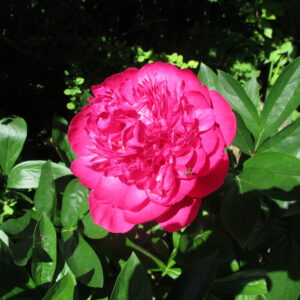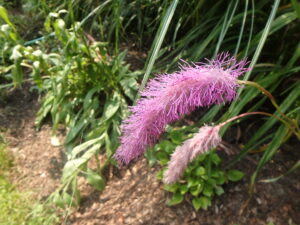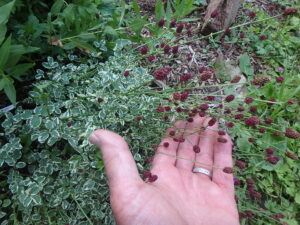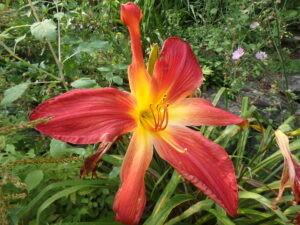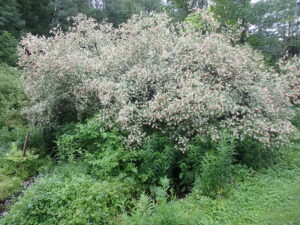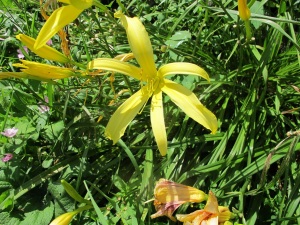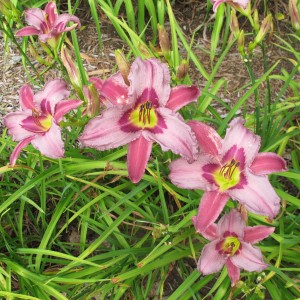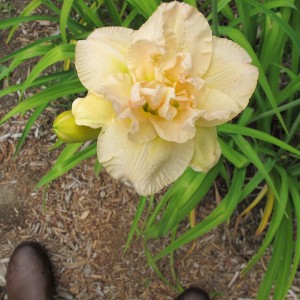On Becoming a Plant Collector
One of the most obsessive collectors I ever met was the late Bill Countryman of Northfield, Vermont. When I interviewed him in the late nineteen nineties he told me that his sister sent him a peony, and although he was in his seventies at the time and not a gardener, he planted it. It bloomed magnificently and Bill fell in love with peonies He decided to grow every type there is.
My absolute favorite of these flowers is one called Sanguisorba hakusenensis ‘Lilac Squirrel’. I saw it on-line, and asked all my local garden centers to no avail, so I finally ordered it from Digging Dog Nursery in California. I planted five small plants last year, they wintered over, and are blooming now. The flowers are like pink squirrel tails hanging down from 18-inch flower stems. They make me smile, especially with a name like that.
Little Angel’s bigger cousin in the same genus is one called ‘Tanna’. This is called a miniature, but that is only relative to some of the bigger ones that get 4- to 6-feet tall. It has very tidy 18-inch leaf stems, each with 13 to 17 leaflets in dark green. It makes a tidy mound and has the same dark-red smallish flowers.
Willows, of course, are more of a problem to collect because of their size, but I do grow at least half a dozen. My favorite is the Salix integra ‘Hakuro nishiki’. It has variegated foliage early in the summer – green and white, and then with pink mixed in for a few weeks. It is colorful and fast growing. Like all willows, it appreciates moist soils but will grow in ordinary garden soil.
Daylilies
Daylilies are wonderful. All beginning gardeners should have several clumps – you essentially can’t kill them. Like many plants, they prefer good rich soil and full sun, but some varieties will survive and thrive most anywhere. They come in a wide range of colors. They have been bred and grown for centuries and by now there are tens of thousands of named varieties. Now is the time when many daylilies are in their prime.
I like to buy flowers in bloom as that way I can better choose the ones that speak to me. So I recently drove to Olallie Daylily Farm in South Newfane, Vermont (www.daylilygarden.com). Chris Darrow, the owner, told me that he has grown at least 2,100 kinds of daylilies, some named varieties, other just bearing numbers from crosses he performed. The farm has about 5 acres of daylilies open to the public, and more daylilies in the 9 acres of field nearby.
Chris Darrow’s grandfather, Dr. George Darrow, was an internationally known daylily breeder, starting in the late 1950’s after retiring from the USDA. For more than 20 years daylilies were his passion. Chris inherited hundreds of varieties from him and has been breeding them himself for over 20 years.
I was interested to learn from Chris that daylilies are easy to breed. Each flower is open for just one day and most are never pollinated. The female part, the pistil, stands up above the male anthers (of which there are usually six), and bees and other insects can visit them and harvest pollen without ever pollinating them. The pollen is not commonly wind-blown often, either. So daylilies seem to wait for us to do the job.
Chris explained that all you have to do is snap off a one of the six anthers and touch it to a pistil. You can self-pollinate a blossom or go to another variety of daylily that you like. Plants that are self-pollinated will not usually produce offspring that are identical to the parent. They may, in fact, have a trait that is emphasized – a tall one bred to itself may produce offspring that are even taller, for example. This allows breeders to develop unique varieties – in several generations.
If you cross two different varieties you might get something that is all new and different, something that is fabulous or something that is absolutely ordinary. It’s a bit like throwing dice – you never know what will show up.
Most daylilies have just 2 sets of chromosomes and are called diploids. Some have 4 sets and are called tetraploids. There are plenty of tetraploid daylilies in existence, and often the blossoms are large and showy. But if you cross a diploid and a tetraploid, you will not get viable seed. So it best if you know your variety name. If you know the name, you can go on-line and look it up at the website of the American Hemerocallis Society (www.daylilies.org). There you can learn if yours is a diploid or a tetraploid. The website has a searchable data base of nearly 80,000 daylilies.
If you want to get seeds, do not snap off the spent flower after it has bloomed. Wait until the green seed pod ripens – it will typically take 40 to 60 days – at which time it will break open. Your job is to pick the pod a little before that happens. If you can squeeze a seed pod and it opens and has dark-colored seeds, it is time to pick it. Chris puts the seed pods from a particular cross into a paper bag. Obviously you will need some sort of numbering and recording system, and a way to identify the parents of the cross.
Daylily seeds need to be cold stratified before planting. This is, essentially, mimicking a winter. Most breeders put seeds in a refrigerator for a minimum of 4 to 6 weeks. Chris Darrow wraps his seeds in moist paper towels for a month starting in February.
To germinate the seeds, Chris Darrow plants them in 32-cell flats in a 60-40 mix of Pro-Mix starting medium and Moo-Doo brand composted cow manure. He puts the seed trays in an unheated greenhouse and lets them warm up slowly. He told me that daylilies are sporadic germinators – seeds might start growing in a week or in a month. It takes 3 years for most daylilies to go from seed to blossom.
If you want to learn more about daylilies, you might want to join the American Hemerocallis Society for $25 a year. That will entitle you to 4 issues of their magazine and a way to connect with other daylily fans. There are regional and national meetings, too.
If you develop a daylily that you think is special, you can register the name with the American Hemerocallis Society for $20. Go to their website, fill out the form, and send it in with a photograph. This can be done on-line or by mail.
Chris’ grandfather lived to be 94 years old. Chris thinks part of Dr. George Darrow’s longevity was his desire to live another year to see what new daylily hybrids blossomed and what they looked like. Maybe that will work for me. I started crossing daylilies last week!
Henry Homeyer is a gardening consultant and author. His website is www.Gardening-Guy.com. You may reach him at henry.homeyer@comcast.net or P.O. box 364, Cornish Flat, NH 03746. Please include a SASE if you want a mail response.
Daylilies
What one kind of flower would you bring with you if you were being sentenced to life on a deserted island? Would you pick peonies for their big, bold blossoms and tantalizing smell? Or perhaps primroses for their bountiful blossoms and willingness to spread? A better choice might actually be daylilies. They’ll grow just about anywhere, are generally untroubled by pests and diseases – and you can eat them! This is daylily season, and a good time to buy some more for your garden.
Let’s start with the common orange daylily (Hemerocallis fulva). Most gardens have some. You’ll also see them by the side of the road as if gardeners – having too many, but unwilling to compost them – have heaved them out the windows of their cars. These sturdy perennials will grow anywhere, and will even bloom in the shade. They were introduced from Asia in the late 1800’s and were admired as exotic at the time, I’m sure. But now they are too common for most gardeners’ taste. And they do spread by root, which can be bothersome.
In the Chinese market in Montreal daylily tubers are for sale for cooking. I’ve tried cleaning and cooking the roots of my own orange daylilies, but have decided that it’s too much work to get them clean enough to eat. They were tasty enough, but fry up almost anything with garlic and onions, and it will be yummy.
The flowers are edible and surprisingly delicious. Make a big green salad and add daylily petals for color. Don’t use the stamens and pistils (the little stuff inside the blossoms) as they’re not tasty. Chop or tear the petals. And toss in a few buds, which taste a bit like asparagus or green beans.
For a nice vegetable dish, sauté chopped onions, shallots or garlic in olive oil or butter. Add a little chopped tarragon and black pepper. When the onions are almost cooked, drop in buds from those common orange daylilies you have been meaning to manage, but haven’t. Select buds an inch to an inch and a half long. They will start to open when they are cooked – in just a minute or two.
For dessert you can take a wine glass and place in it a fully open, brightly-colored daylily blossom. Put in a scoop of sherbet in the blossom and garnish with a few fresh berries and a mint leaf if you have one. Yum!
Daylilies are great cut flowers. Because each blossom only lasts a day – hence the name – most people don’t use them in flower arrangements. But I cut scapes (leafless stems) that are just starting to bloom and have numerous fat, unopened buds. The buds will open one at a time for up to a week, depending on number of buds. This works most reliably if the arrangement gets some sunshine each day.
I recently visited Cider Hill Gardens in Windsor, VT to admire their collection of daylilies. They have daylilies in a wide range of colors, from nearly white (‘Ice Carnival’) to deep reds that border on black. They have daylilies that are pink, creamy yellow or light orange, lilac, lavender, bluish and red. Some come in one color, but most are bi-colored, with a throat or eye of a second color. Each flower has both petals and sepals, and in some, like ‘Frans Hals’, the petals and sepals can be different colors – a look I like.
Flower shape varies as much as the colors. There is the standard trumpet. Then there are those with ruffled edges (‘Here She Comes’ is a good one). And the so-called ‘spiders’, whose petals are narrow and spaced apart a little – like the legs of a spider. ‘Kindly Light’ is a nice yellow one. ‘Doubles, such as ‘Jean Swann’ have their centers filled in with lots of extra petals. And some are worth buying for their great names like ‘Blueberry Breakfast’ or ‘Bodacious’.
Then there are the re-blooming daylilies, like Stella de Oro, a gold-colored daylily that is very popular because it blooms off and on all summer. I’ve seen pictures of a re-bloomer called Purple de Oro that I simply must have. So many kinds, so little garden space!
What do daylilies want in life? Sunshine, dark rich soil, and adequate moisture. But they will settle for less – even a lot less- and bloom almost anywhere. Yes, slugs will sometimes nibble on the leaves, but they are not a magnet for bugs the way some roses are.
Over time clumps of daylilies get bigger, and you can divide them to start new clumps. Simply slice through a big clump with a spade to make two or four new plants, pry them apart and re-plant. I’ve been known to take out a chunk shaped like a piece of pie with a serrated knife – and the mother plant never even seemed to notice I’d done so. So run to your neighborhood plant center and have a look – you’ll likely come home with something wonderful.
Henry Homeyer is the author of 4 gardening books, and a children’s fantasy-adventure, Wobar and the Quest for the Magic Calumet. Contact Henry through his Web site, www.Gardening-Guy.com.



